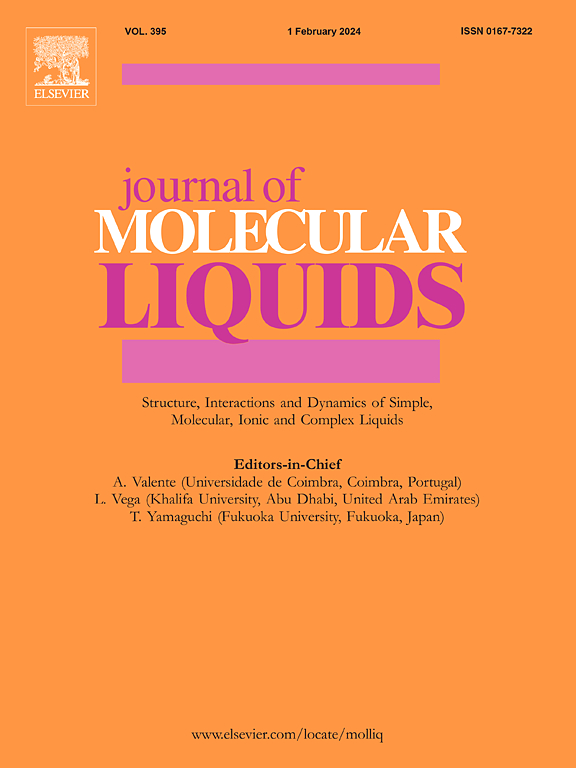青蒿素在酸性深共晶溶剂中溶解度的分子动力学和DFT分析:对癌症药物传递的意义
IF 5.2
2区 化学
Q2 CHEMISTRY, PHYSICAL
引用次数: 0
摘要
本研究采用分子动力学模拟(MD)和密度泛函数理论(DFT)研究了青蒿素(ART)在三种酸性深共晶溶剂(DES)中的溶解度,这些溶剂分别是氯化胆碱(ChCl)与酒石酸(TA)、抗坏血酸(AA)和丙二酸(MA)。结果表明,ART在DES体系中的溶解度显著提高,特别是在ChCl/TA体系中,其中明显没有自聚集,与在水中观察到的聚集形成鲜明对比。氢键动力学表现出ART和AA之间的强相互作用,而ChCl/TA之间的相互作用则很小。DFT计算表明,ART的能带隙减小的顺序如下:water>;ChCl / AA>ChCl /马比;ChCl /助教。这种趋势与药物反应性及其溶剂化能的增加有关。此外,该研究还探讨了ART与癌细胞膜的相互作用,揭示了在ChCl/MA和ChCl/TA存在的情况下,ART对细胞膜的渗透作用显著,而ART在水和ChCl/AA的界面上仍然主要存在。结构分析表明,ART显著影响了DES溶剂中的平均脂质面积和膜厚度,其中ChCl/TA体系的变化最为明显。这些发现强调了溶剂组成在介导ART与脂质双分子层相互作用中的关键作用,表明深共晶溶剂可以增强药物传递并提高癌症治疗的疗效。本文章由计算机程序翻译,如有差异,请以英文原文为准。

Molecular dynamics and DFT analysis of artemisinin solubility in acidic deep eutectic solvents: Implications for cancer drug delivery
This study employs molecular dynamic simulations (MD) and density functional theory (DFT) to investigate the solubility of artemisinin (ART) in three acidic deep eutectic solvents (DES): Choline chloride (ChCl) combined with tartaric acid (TA), ascorbic acid (AA), and malonic acid (MA), in comparison to water. The results demonstrate a significant enhancement in the solubility of ART within the DES systems, particularly in ChCl/TA, where self-aggregation is notably absent, contrasting sharply with the aggregation observed in water. The dynamics of hydrogen bonding exhibit strong interactions between ART and AA, whereas interactions in ChCl/TA are minimal. DFT calculations indicate a decrease in the energy band gap of ART in the following order: water> ChCl/AA> ChCl/MA > ChCl/TA. This trend correlates with an increase in drug reactivity and its solvation energy. Additionally, the study explores ART's interactions with cancer cell membranes, revealing significant penetration into the membranes in the presence of ChCl/MA and ChCl/TA, while ART remains predominantly at the interface in both water and ChCl/AA. Structural analyses demonstrate that ART significantly affects the average area per lipid and membrane thickness in the DES solvents, with the most pronounced alterations observed in the ChCl/TA system. These findings underscore the critical role of solvent composition in mediating interactions between ART and the lipid bilayer, suggesting that deep eutectic solvents can enhance drug delivery and improve therapeutic efficacy in cancer treatment.
求助全文
通过发布文献求助,成功后即可免费获取论文全文。
去求助
来源期刊

Journal of Molecular Liquids
化学-物理:原子、分子和化学物理
CiteScore
10.30
自引率
16.70%
发文量
2597
审稿时长
78 days
期刊介绍:
The journal includes papers in the following areas:
– Simple organic liquids and mixtures
– Ionic liquids
– Surfactant solutions (including micelles and vesicles) and liquid interfaces
– Colloidal solutions and nanoparticles
– Thermotropic and lyotropic liquid crystals
– Ferrofluids
– Water, aqueous solutions and other hydrogen-bonded liquids
– Lubricants, polymer solutions and melts
– Molten metals and salts
– Phase transitions and critical phenomena in liquids and confined fluids
– Self assembly in complex liquids.– Biomolecules in solution
The emphasis is on the molecular (or microscopic) understanding of particular liquids or liquid systems, especially concerning structure, dynamics and intermolecular forces. The experimental techniques used may include:
– Conventional spectroscopy (mid-IR and far-IR, Raman, NMR, etc.)
– Non-linear optics and time resolved spectroscopy (psec, fsec, asec, ISRS, etc.)
– Light scattering (Rayleigh, Brillouin, PCS, etc.)
– Dielectric relaxation
– X-ray and neutron scattering and diffraction.
Experimental studies, computer simulations (MD or MC) and analytical theory will be considered for publication; papers just reporting experimental results that do not contribute to the understanding of the fundamentals of molecular and ionic liquids will not be accepted. Only papers of a non-routine nature and advancing the field will be considered for publication.
 求助内容:
求助内容: 应助结果提醒方式:
应助结果提醒方式:


